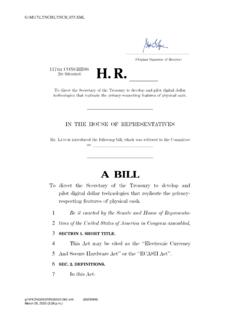Transcription of Healthcare Service Delivery Transformation: Trends in Care ...
1 Healthcare Service Delivery transformation : Trends in Care Delivery and Community Health Webinar hosted by the Office for State, Tribal, Local and Territorial Support Centers for Disease Control and Prevention (CDC). June 20, 2013. 3:30 pm 5:00 pm (EDT). Summary Speakers Paula Staley Senior Healthcare Advisor, Office for State, Tribal, Local and Territorial Support, CDC. Mike Van Den Eynde Director, Deloitte Consulting LLP. Bob Williams Director, Deloitte Consulting LLP. Ellen Benavides Assistant Commissioner, Minnesota Department of Health John Auerbach Director, Institute on Urban Health Research PPT Presentation can be found at Introduction Speaker: Paula Staley, Senior Healthcare Advisor, Office for State, Tribal, Local and Territorial Support, CDC. The Healthcare Delivery and financing system is in the midst of transformation as it shifts from an episodic, fee-for- Service model to an integrated, value-based Healthcare Service Delivery and financing model.
2 Health care and public health are faced with a unique window of opportunity to work together to lower costs and improve health; however, both fields have different cultures and speak different languages. The challenge is to find the most effective way public health can support the health system's adoption of patient-centered care that improves health and saves costs in both the short and long terms. To overcome this challenge, public health must understand the strategic changes taking place, as well as the future desired state of integrated clinical, community, and public health care. Public health providers must recognize the needs of the clinical care health system, the role public health can play, and the value public and community health can bring to the Healthcare system. The goals of this webinar are to provide a foundational understanding of the drivers, changes, and implications affecting providers and Healthcare Service Delivery ; detail new value-based models; and give examples of health agencies beginning to integrate into the models.
3 Trends in Care Delivery and Community Health Webinar Summary 1. Overview of Changes in Healthcare Delivery Speaker: Mike Van Den Eynde, Director, Deloitte Consulting LLP and Bob Williams, Director, Deloitte Consulting LLP. The US health system is undergoing a critical transformation as it shifts from volume- to value-based Delivery . Current stakeholders ( , payers, employers, consumers, suppliers, government, medical groups, and health systems) face both challenges and opportunities during this transformation . These include re-alignment of the health Service mix, focus on increased engagement with patients and collaboration with providers, shifts in customer base, diversification into other types of business, and pressure to lower costs. As stakeholders address these changes, both access and quality must be managed, maintained, or improved and costs must be reduced. US Healthcare prices are many times more expensive than those in the rest of the industrialized world.
4 However, the status quo in the current environment is unsustainable, specifically as health insurance exchanges increase individual enrollment, hospital margins continue to decline requiring capture of premium dollars through broader structures ( , extended networks and accountable care organizations). Furthermore, market regulatory forces drive alignment of physicians and hospitals using new models such as acquisition, physician groups, and joint ventures. Already, about 80% of primary care providers have been acquired by or work with a hospital. Providers are pursuing four key strategies to improve revenue performance and maintaining or improving quality of care: Delivering superior outcomes Monetizing assets Acquiring more hospitals and streamlining operations Integrating care across the continuum to decrease use and total cost Accountable Care Organizations (ACOs). The goal of ACOs is to drive Healthcare transformation to a patient-centered care model that promotes access, coordination, wellness and prevention in a risk-based financial model.
5 ACOs strive toward a collaboration that allows physicians to successfully manage the health (not just health care) of their patients and thrive in a risk-based financial environment. Components of ACOs include Support for high risk patients Coordination of care across the care continuum Facilitated and ensured access Shared decision-making and accountability with patients and their caregivers Promotion of wellness and prevention Measuring and monitoring processes and outcomes Providers continue to participate in various value-based care (VBC) models that drive clinical integration and include financial risk based on performance. These models include Medicare Shared Savings Program, Payer/Providers Partnerships, Expanded Risk, and Comprehensive/Global models. Strategies of these models typically have one or more of the following components: Unit cost leadership uses select partnerships to lower costs while maintaining or improving quality Use management focuses on alternative care Delivery models and integration to improve health Population management and revenue diversification leverages brand, reputation, and relationships to extend into new product lines and services Trends in Care Delivery and Community Health Webinar Summary 2.
6 Health information technology (HIT) is a critical asset for understanding the health system's current landscape and identifying opportunities for integration and collaboration. Interoperability and data sharing, , health information exchange between clinical care, public health, and community-based services , are key to understanding population health. HIT also includes analytics and business intelligence. A HIT infrastructure can allow for data compilation and analysis on an individual level, patient panel, health plan, and hospital Service area, as well as geographic population. Patient-Centered Medical Homes A patient-centered medical home (PCMH) integrates patients as active participants in their own health and well-being. A physician leads a medical team that coordinates all aspects of preventive, acute, and chronic needs, using the best available evidence and appropriate technology to care for the patient.
7 These relationships offer patients comfort, convenience, and optimal health throughout their lifetimes. Critical components include Building patient provider relationships Maintaining a patient registry Reporting on performance systematically and at the population level Managing care for individuals using a care team and collaborative action plan PCMH models provide extended access, links to community, preventive and public health services , and patient self-management support. Blended payment models will be determined by the quality of care provided, how physicians and practices meet performance standards, and include care coordination fees, office visit fees, and performance bonuses. PCMH models have proven successful in various settings. Overview of the Minnesota Experience Speaker: Ellen Benavides, Assistant Commissioner, Minnesota Department of Health Minnesota has explored a range of community-led public health initiatives and policy approaches to public health integration.
8 As part of their State Innovation Model (SIM) award, they are building on the Healthcare Delivery system demonstration project focusing on integrating public health and behavioral health with clinical care. Additionally, they are working on an initiative to broaden the public health workforce, using community health workers, paramedics, and other non-clinical staff. They are creating data analytics and information exchanges for systems that do not yet have electronic medical records. Regarding ACOs, Minnesota is piloting a new initiative called Accountable Communities for Health (ACHs). ACHs will develop models that integrate behavioral health and primary care, while focusing on enhancing community engagement in ACOs. As a multi-payer system, the initiative will link to Medicare and Medicaid populations. Communities will be able to self-define their scope. ACHs represent a total investment in community health rather than cost of clinical care only.
9 Metrics are being developed to measure the success of the initiative. In terms of financial sustainability, the state plans will continually build infrastructure and find ways to transfer funds from the broader health system to the ACHs. For more information about Minnesota's plan, see reform/images/SIM%2520 Executive%2520 Summary% Trends in Care Delivery and Community Health Webinar Summary 3. Overview of the Massachusetts Experience Speaker: John Auerbach, Director, Institute on Urban Health Research Massachusetts has undertaken several initiatives to integrate public health into their clinical health system. One bold initiative has been to phase out services that can be transitioned into primary care medical homes. For instance, the state has phased out grant support for sexually transmitted disease clinics in favor of moving those services into primary care medical homes, which was successful because access to primary care in the population is so widespread (98%).
10 A community-based initiative to improve population health is Mass in Motion, a statewide campaign focused on nutrition and physical activity. Another initiative used community health workers to provide asthma care to families with children who have asthma. Piloted in Boston hospitals, this initiative is now being implemented and evaluated more broadly by Medicaid. The Department of Public Health also demonstrated its ability to address quality and cost by targeting hospital-associated infections and other preventable clinical care issues. At the policy level, the state is changing regulations that govern primary care and behavioral health clinics so that integration is easier. Two challenges include differing definitions of population health and the tension between long-term and short-term outcome measures. Questions and Answers What was the reaction of providers to Massachusetts payment reform?

















